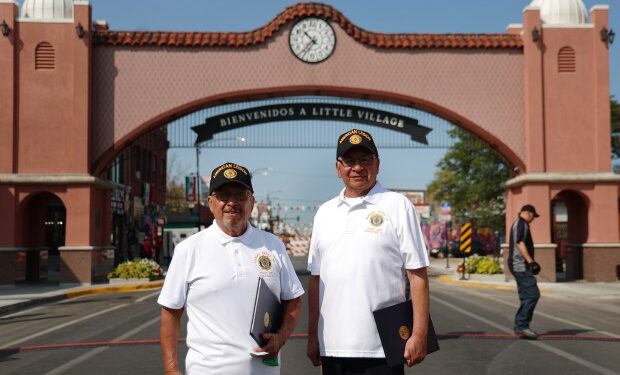For the last three decades, a majestic arch above West 26th Street has served as a gateway to Little Village, the largest and most recognized Mexican immigrant community in Chicago.
“Bienvenidos A Little Village,” reads a banner right below a grand mechanical clock that, ironically, did not tell time for as long as most people can remember.
But on Wednesday, right after the clock marked 10 a.m., Mayor Brandon Johnson, city officials and the Little Village Chamber of Commerce celebrated its restoration and solidified the significance of the presence of Mexican immigrants and Mexican Americans here.
The arch, which resembles the arched entrances found in rural towns in Mexico, underwent a comprehensive restoration over the last year after it was designated a city landmark in 2022.
The project, spearheaded by the Chicago Department of Transportation, rehabilitated the structure to preserve its original character. The original Mexican clock manufacturer restored the elements of the arch’s iconic clock.
“This arch is a symbol of Little Village’s culture, people and what I like to call the soul of who we are,” Johnson said. “It’s important that this arch stands the test of time and, of course, we have to remain proud, because it is a representation of Chicago’s Mexican community.”
The project also included reparations of nearby sidewalks, pavements and planters. During the ceremony, Johnson committed to investing in “the strength and vibrancy” of Little Village and other Mexican communities across Chicago.
According to the latest census data, one of every five Chicagoans is of Mexican descent. La Villita has long been a principal port of entry for Mexican immigrants to the Midwest, creating a culture of colors, smells and a character that resembles that of a small town in Mexico.
For many, the arch is a “piece of Mexico,” said Gerardo Guerrero, deputy consul of the Consulate General of Mexico in Chicago. “It’s not just the arch that reminds us of our Mexico. You can also smell the scent of the tortillas.”
Guerrero thanked officials for the recognition of the arch as a landmark and commended the resilience of the Mexican community in Chicago and the contribution of immigrants in the country economically and culturally.
Mothers with their children, abuelos and many more workers passed by as officials spoke of the residents’ contributions and the significance to the fabric of the city.
It was in 1987 when then-Ald. Jesús “Chuy” García and community members proposed the idea of a celebratory marker to highlight the growing population of Mexicans.
Designed by Mexican architect Adrián Lozano, the arch was built over six months in late 1990. In 1991, Mexico’s president at the time, Carlos Salinas de Gortari, visited Chicago and stopped in Little Village to speak at a rally near the new arch.
Salinas reassured the crowd that the Mexican government had not forgotten them. Salinas gave the city and community the bronze clock — manufactured by Relojes Centenario, the oldest clockmaker in Mexico — to be installed on the arch.

Ronald J. Baltierra, 77, and David Ramirez, 76, two Vietnam War veterans who helped to build the arch, attended the ceremony Wednesday morning, overwhelmed by joy and emotion after Johnson presented them with a proclamation in honor of their contribution to Chicago.
“I put my heart, my soul, everything into it when I had the opportunity to build this,” said Baltierra, whose family is from Salamanca and Irapuato, Guanajuato. “This (arch) means so much to me right now. Even though … I’m proud to be an American — I’ll fight for America, I’ve done it once and I’ll do it again — but it means so much to me to build something like this knowing that that’s where my heritage is.”
Baltierra, who now lives in the suburb of Downers Grove, said he visits La Villita every time his children and children are in town.
“I want them to be proud of this too,” Baltierra added.
Ramirez stood by Baltierra’s side as he recalled the time they helped Little Village homeowners repair and renovate their homes under a city program. The two were members of American Legion, a veterans organization devoted to mutual helpfulness.
“We’re very proud to be here and represent the original builders 35 years ago. We really appreciate the restoration that they’ve done here. It is almost exactly as we constructed it,” Ramirez said.
The ribbon-cutting ceremony came just days before the celebrations and commemoration of Mexican’s Independence Day across the city on Monday. For the first time in almost 40 decades, an official ceremony to honor Mexicans in Chicago will take place downtown Sunday night.
“This is a time to recognize all the ways in which Chicago’s Mexican community has enriched our lives and the city,” Johnson added, highlighting the economic strength of the 26th Street corridor, mostly made up of immigrant and family businesses.
Originally Published:







